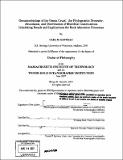| dc.contributor.advisor | Wolfgang Back and Katrina J. Edwards. | en_US |
| dc.contributor.author | Santelli, Cara M | en_US |
| dc.contributor.other | Woods Hole Oceanographic Institution. | en_US |
| dc.date.accessioned | 2008-03-27T18:31:23Z | |
| dc.date.available | 2008-03-27T18:31:23Z | |
| dc.date.copyright | 2007 | en_US |
| dc.date.issued | 2007 | en_US |
| dc.identifier.uri | http://hdl.handle.net/1721.1/40967 | |
| dc.description | Thesis (Ph. D.)--Joint Program in Oceanography (Massachusetts Institute of Technology, Dept. of Earth, Atmospheric, and Planetary Sciences; and the Woods Hole Oceanographic Institution), 2007. | en_US |
| dc.description | Includes bibliographical references. | en_US |
| dc.description.abstract | Basaltic ocean crust has the potential to host one of the largest endolithic communities on Earth. This portion of the biosphere, however, remains largely unexplored. In this study, we utilize molecular biological, microscopic, and geochemical tools to gain a better understanding of the geomicrobiology of the ocean crust. Specifically, we examine the phylogenetic diversity of microorganisms inhabiting basaltic lavas, the activities and abundances of these microorganisms, the spatial extent of the biosphere, and the potential effect that microbial activity has on the geochemistry of the ocean crust and overlying water column. Our study demonstrates that young, fresh volcanic lavas near mid-ocean ridges host an incredibly diverse and dense population of microorganisms dominated by Bacteria, quite distinct from the microbial communities found in surrounding deep seawater and hydrothermal vents. Furthermore, these communities may contribute to the elemental cycling of Fe, S, Mn, N, and C in this environment. The inability to definitively identify microorganisms in drill-cores of old (> 15 Ma) ocean crust, however, implies that these once prolific communities may become scarce as the crust ages and moves further away from the ridge axis. Finally, we provide evidence suggesting that these communities are fueled by oxidative alteration reactions occurring in the basaltic crust. | en_US |
| dc.description.statementofresponsibility | by Cara M. Santelli. | en_US |
| dc.format.extent | 217 p. | en_US |
| dc.language.iso | eng | en_US |
| dc.publisher | Massachusetts Institute of Technology | en_US |
| dc.rights | M.I.T. theses are protected by
copyright. They may be viewed from this source for any purpose, but
reproduction or distribution in any format is prohibited without written
permission. See provided URL for inquiries about permission. | en_US |
| dc.rights.uri | http://dspace.mit.edu/handle/1721.1/7582 | en_US |
| dc.subject | Earth, Atmospheric, and Planetary Sciences. | en_US |
| dc.subject | Joint Program in Oceanography. | en_US |
| dc.subject | Woods Hole Oceanographic Institution. | en_US |
| dc.subject.lcsh | Sediments (Geology) Microbiology | en_US |
| dc.subject.lcsh | Biogeochemical cycles | en_US |
| dc.title | Geomicrobiology of the ocean crust : the phylogenetic diversity, abundance, and distribution of microbial communities inhabiting basalt and implications for rock alteration processes | en_US |
| dc.type | Thesis | en_US |
| dc.description.degree | Ph.D. | en_US |
| dc.contributor.department | Joint Program in Oceanography | en_US |
| dc.contributor.department | Woods Hole Oceanographic Institution | en_US |
| dc.contributor.department | Massachusetts Institute of Technology. Department of Earth, Atmospheric, and Planetary Sciences | |
| dc.identifier.oclc | 213281553 | en_US |
